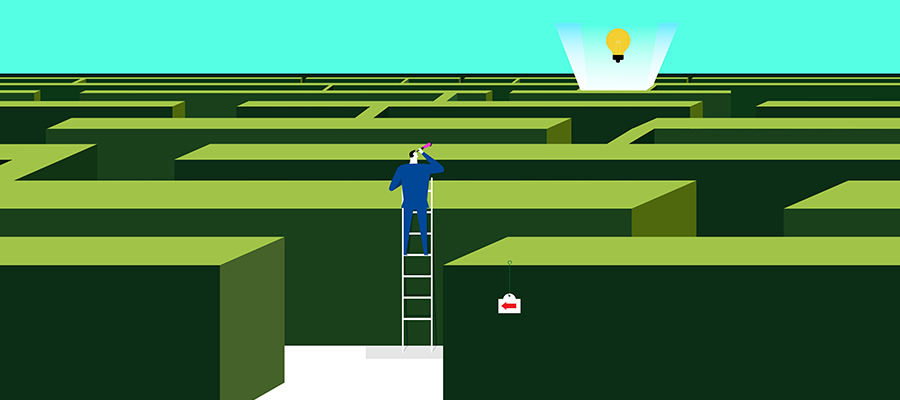We are all quite familiar with the phenomenon of optical illusions, but less so with the phenomenon of cognitive biases. However, these perceptual distortions that are to our mind what optical illusions are to our visual system lead us to make wrong judgments or bad decisions daily. These mental shortcuts that allow the brain to simplify information processing are inevitable, but we can learn to detect them better, starting with a better knowledge of them.
In your brain
I invite you at the outset to answer spontaneously to the following riddle:
“I am the sister of two Olympic gymnasts. Yet these two gymnasts are not my sisters. How is that possible?”
You can see the solution later in the article. Congratulations, if you got the right answer! Your critical mind is well trained. However, chances are you made a mistake, even though you thought you were thinking logically and rationally. In fact, it is your brain that has managed to deceive you, as it very often does, through cognitive processes that allow it, under certain constraints, to provide quick and intuitive answers that seem to be satisfactory… on the surface.
The underside of cognitive bias
As we explain in the article The 3 Speeds of Thought, when these intuitive thoughts mislead us, they are referred to as “cognitive bias”. As we explain in this article, this cerebral process is automatic and unconscious. While we can intervene on it to some extent after the fact, it remains impossible to prevent.
According to a recent classification by Buster Benson (2016), there are four reasons why the brain uses cognitive biases:
- an overabundance of information to be processed;
- the need to make sense;
- the need to act quickly;
- the need to memorize information for later use, given our limited cognitive abilities.
Some 250 cognitive biases are generally classified into one of the following five categories:
| Bias… | our perception is affected by… |
|---|---|
| attentive or of attention | selective factors of our attention |
| mnemonic | factors related to our memory |
| of judgment | a distortion of our judgment |
| of reasoning | paradoxes in our reasoning |
| linked to the personality | socio-cultural factors |
Note that some also include sensory-motor biases in this categorization. However, since the latter are part of another form of process (sensory and motor), it is more accurate to call them “illusions” related to the senses and motor skills — think of the optical illusion.
A sample
According to researcher Olivier Houdé, developing critical thinking and metacognitive skills, as well as having some distance from one’s emotions when making a decision is necessary to better fight against the traps our brain sets for us. Knowing some of the different cognitive biases that have been identified so far, a sample of which is given below, is also useful, if only to become aware that we are indeed victims of them…
Confirmation bias. Also called hypothesis confirmation bias, this cognitive bias is the tendency to favour information that is consistent with our assumptions or preconceived ideas and to underestimate or ignore information that works against them.
The fundamental attribution error. Sometimes called internality bias, the fundamental error of attribution consists of overestimating the personal characteristics of individuals — their personality, opinions, intentions, etc. — to explain their behaviour and to underestimate the external and situational factors that could be considered.
Overconfidence. This cognitive bias, which is said to affect more than half of us (!), consists of overestimating one’s abilities, especially in relation to those of others. Many of us would, therefore, feel that we have above-average intelligence…
The anchoring bias. Also known as starting point bias, anchoring bias is the tendency to misuse information, often the information acquired first, as a reference for making a decision and to no longer take new information into account. Note that in psychological jargon, “anchoring” refers to the difficulty in getting rid of a first impression.
Retrospective bias. This cognitive bias — which can be summed up by the classic “I knew it all along” — consists of overestimating, after an event has taken place, the fact that it was predictable or probable. The goal is to bring the present (the event once it has occurred) into line with the past, or the context preceding the event.
Riddle solution: “These two Olympians are my brothers! Just because I’m a girl doesn’t mean I only have sisters.”
Related articles:
- The 3 Speeds of Thought
- Metacognition 101
- Metacognition in 3 Questions
- Develop Your Metacognitive Skills
- The importance of emotions in learning
- Dealing with uncertainty in 3 steps
- Neuroscience: Learning in 4 Steps
- Education through the lens of neuroscience
- 7 myths about learning, debunked by neuroscience
- The adult brain learns best with stories
- Deciphering Attention
- Attention, in numbers
- Learning and Forgetting: New Perspectives on the Brain
- 8 Types of Memory… to Remember!
- The fascinating brain: 5 amazing facts
Author:
Catherine Meilleur
Creative Content Writer @KnowledgeOne. Questioner of questions. Hyperflexible stubborn. Contemplative yogi.
Catherine Meilleur has over 15 years of experience in research and writing. Having worked as a journalist and educational designer, she is interested in everything related to learning: from educational psychology to neuroscience, and the latest innovations that can serve learners, such as virtual and augmented reality. She is also passionate about issues related to the future of education at a time when a real revolution is taking place, propelled by digital technology and artificial intelligence.







Leave A Comment